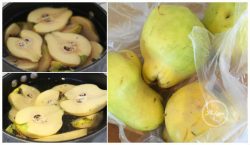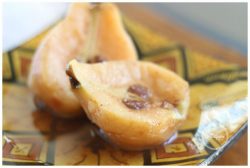 I WILL admit I go through obsessional phases with certain foods. Looking through my October menus, despite there being a broad range of occasions – think Jewish New Year to partridge shoot suppers – there has definitely been a leaning towards one particular ingredient.
I WILL admit I go through obsessional phases with certain foods. Looking through my October menus, despite there being a broad range of occasions – think Jewish New Year to partridge shoot suppers – there has definitely been a leaning towards one particular ingredient.
Pomegranates, anchovies, star anise, honey, caraway, venison are some of the foods that have had their moments as the centre of my culinary attention, (thankfully with not too much overlapping) but right now, clients are highly likely to see me suggest quinces on their menu, as I cannot seem to get enough of these mysteriously rewarding fruits.
History and literature show a fondness for the quince . The first records are of them being planted in 1275 at the tower of London during the reign of Edward I.
Paris gave Aphrodite a quince in exchange for the love of the most beautiful woman in the world, Helen of Troy. The fruit is often pictured in Aphrodite’s hand as a symbol of love. Up to the 18th century the soon to be father-in-law would often give a basket of quince to the bride to bring happiness to the marriage (not necessarily a sure fired method but at least something to throw if things quickly turned sour). And don’t forget this fruit was also part of the marital feast for the surprisingly romantically entwined couple, the owl and the pussy cat – “They dined on mince, and slices of quince.”
 Although there were plenty of traditional and symbolic foods that had to be woven into the Rosh Hashanah supper, celebrating the start of the Jewish New Year, I also managed to accommodate some quince. Planning the Rosh Hashanah meal was a fascinating task as there is so much symbolism with the food.
Although there were plenty of traditional and symbolic foods that had to be woven into the Rosh Hashanah supper, celebrating the start of the Jewish New Year, I also managed to accommodate some quince. Planning the Rosh Hashanah meal was a fascinating task as there is so much symbolism with the food.
The meal starts with honey, apples, pomegranates, dates, challah and blessings and then moves on to other dishes like fish, meatballs and of course dessert. Here are a few of the foods and why they are included in the feast.
Apple and honey: to bring in a sweet new year
Round challah loaves: to symbolise the continuity of creation (these came from the best bakery in London which involved queuing for hours at night – admittedly not by me).
Pomegranates: representing a new fruit in season, to wish our good deeds for the new year will be as many as the seeds in a pomegranate and to be thankful for bringing us into the new year.
 Fish complete with head: to symbolise the start of the year and moving forward and to remember it as the ancient symbol for fertility and abundance.
Fish complete with head: to symbolise the start of the year and moving forward and to remember it as the ancient symbol for fertility and abundance.
Leeks: the word for leeks is related to the work to cut kareyt, so the leeks symbolise cutting away those who wish to harm us.
Dates: similar in Hebrew to a word translating “to end”, so dates are eaten in the hope that enemies will cease; also it is generally believed that when Israel is called the land of milk and honey that refers to date honey.
Beetroots and their leaves: The Hebrew word for beets is selek and is similar to the word for “remove.” Beetroots are eaten in hope of causing the departure of our enemies.
Then there was the partridge shoot weekend near Chichester where again I managed to accommodate quince based dishes.
 It is worth noting while we are in the height of shoot season that quince goes really well with game as its fragrant flavours contrast well with the earthiness of the meat. So here’s a basic method of cooking quince which you can then add to other dishes.
It is worth noting while we are in the height of shoot season that quince goes really well with game as its fragrant flavours contrast well with the earthiness of the meat. So here’s a basic method of cooking quince which you can then add to other dishes.
This month: Dishes involving quince, 15; cocktails drunk with quince juice: count unreliable but lets say more than one; every home should – quince tree; Peter Quince is a character is Shakespeare’s, A Midsummer Night’s Dream; the apple of my eye is in fact a quince
 Baked quince with brandy, cinnamon and star anise
Baked quince with brandy, cinnamon and star anise
This recipe can be seen as just a starting point. Once the quince is cooked you can simply serve as is with cream, ice cream, crème fraiche or yogurt. To take it further you can chop it up and add to apple pies, crumbles, stewed brambles (blackberries) to eat as a compote; whizz it up and make into sorbet; one of my favourite uses is adding the fragrant cooking liquid to cocktails.
Serves 8
8 quinces
3 sticks of cinnamon
1 tsp ground ginger
2 star anise
400g light brown sugar
water
1 and a bit glasses of brandy
Peel the quinces and chop in half vertically. Place in a pan with spices, the sugar, top up with water and add a glass of brandy. Bring to a simmer then pop on a lid and cook until the quinces are all soft – this can vary greatly in time but start checking after 30 minutes.
Once cooked add a splash more brandy and serve two halves each, warm or cold, in a bowl with some of the juice and a dollop of cream,
The quinces will keep well In their juice in the fridge for at least a week (unless I am around).
Read more of Philippa’s travels and discover more recipes on her website www.philippadavis.com